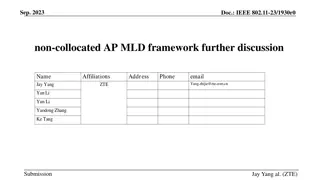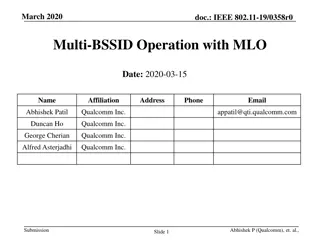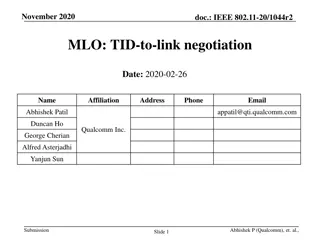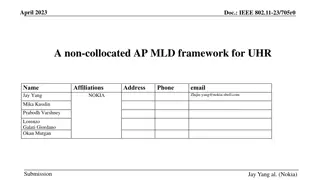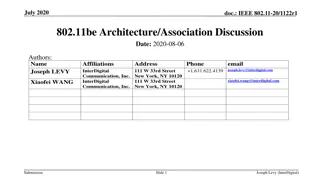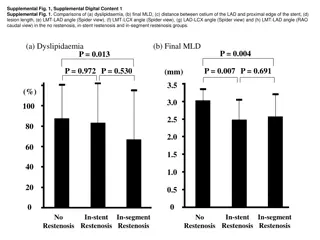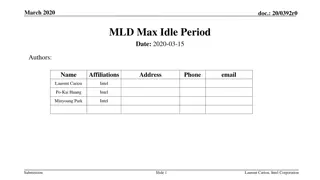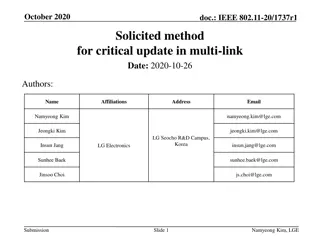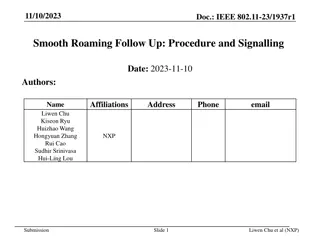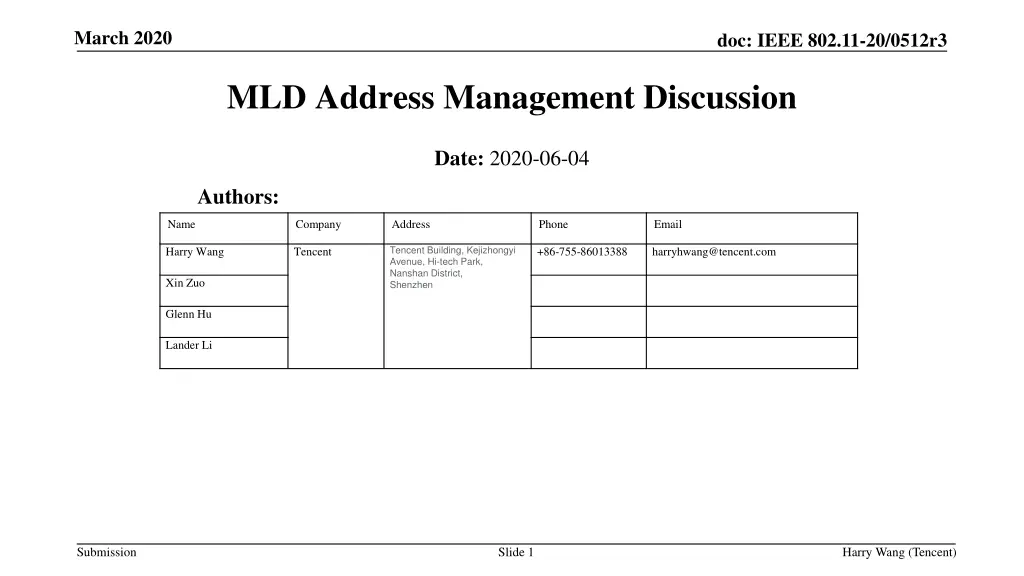
IEEE 802.11-20 MLD Address Management Discussion
"Explore the intricacies of MAC address management in IEEE 802.11-20 MLD protocol, discussing the uniqueness of addresses, roles in AP and non-AP setups, and principles guiding address allocation. Delve into the complexities of configuring addresses for seamless MLD BSS operation. Discover the necessity of distinct addresses for MAC-SAP and MLD-SAP functions to ensure efficient network operations."
Download Presentation

Please find below an Image/Link to download the presentation.
The content on the website is provided AS IS for your information and personal use only. It may not be sold, licensed, or shared on other websites without obtaining consent from the author. If you encounter any issues during the download, it is possible that the publisher has removed the file from their server.
You are allowed to download the files provided on this website for personal or commercial use, subject to the condition that they are used lawfully. All files are the property of their respective owners.
The content on the website is provided AS IS for your information and personal use only. It may not be sold, licensed, or shared on other websites without obtaining consent from the author.
E N D
Presentation Transcript
March 2020 doc: IEEE 802.11-20/0512r3 MLD Address Management Discussion Date: 2020-06-04 Authors: Name Company Address Phone Email Tencent Building, Kejizhongyi Avenue, Hi-tech Park, Nanshan District, Shenzhen Harry Wang Tencent +86-755-86013388 harryhwang@tencent.com Xin Zuo Glenn Hu Lander Li Submission Slide 1 Harry Wang (Tencent)
March 2020 doc: IEEE 802.11-20/0512r3 MAC Addresses for MLD Commonly, a Wi-Fi device has ONE pre-installed global unique MAC address: The 48-bit address is composed by a 24-bit OUI, bought from IEEE, and a 24-bit extension The MAC address is used to identify both MAC-SAP and MLME-SAP Encapsulated in the TA/RA field in the MAC header The uniqueness of the address is guaranteed solely by the OUI prefix For other types of prefix such as CID, SAI, and AAI, there is no guarantee of unique MAC address For AP, the MAC address provides the basis of Multi-BSSID In a multi-link BSS, the consumption of MAC addresses will be boosted by multiple times compared to the legacy, all MAC functions require unique addresses. For .11be MLD, it is preferable to have only ONE pre-installed MAC address as the legacy A single pre-installed MAC address for MLD MAC-SAP; A mechanism to configure the address for each link with respect to functional requirements (slide 3,4) already agreed Submission Slide 2 Harry Wang (Tencent)
March 2020 doc: IEEE 802.11-20/0512r3 Background Multiple Addresses MLD address issues have been discussed in the group [1,2,3,4,5] as a function of MLO; Some of general principles are summarized as follows, MAC SAP may need unique* address, which may be used to identify a MLD on DS, i.e the MLD address z; STAs may have separate addresses x/y i.e the STA/MAC/Link address, which may be the same or different as the MLD address z; AP MLD is preferred to have different STA address (x y) for the backward compatibility with legacy STAs; Non-AP MLD is therefore to use different STA addresses to enable symmetric operations, and to honor existing authentication process. In nutshell, (x,y) is used for STA (low MAC) and (z) is for MLD (high MAC), if the MAC functions are separated in 11be. With the support of Multiple BSSID, many more MAC addresses need to be managed by AP MLD. Addr(z) MAC SAP MLD Addr(y) Addr(x) STA 1 STA 2 Submission Slide 3 Harry Wang (Tencent)
March 2020 doc: IEEE 802.11-20/0512r3 Address for Different Purposes During MLD BSS setup, AP MLD needs to inform both its MLD address (z) and the STA addresses (x, y) to Non-AP MLD, and only the STA addresses (x or y) to the legacy; Non-AP MLD should present all its addresses to AP MLD as well, so that The connection being setup on one link works for all links; After successful setup, TA/RA in MAC headers are preferred to use STA address (say x); SA/DA for MSDUs are preferred to use MLD address (z); All MLD, both AP and Non-AP, should have at least a MLD address built-in or pre-installed by the network administrator, that is unique at some extent. Addr(z) MAC SAP MLD Addr(y) Addr(x) STA 1 STA 2 Submission Slide 4 Harry Wang (Tencent)
March 2020 doc: IEEE 802.11-20/0512r3 Proposal In this contribution, we propose to use dynamic allocation and management for the STA addresses for both AP and Non-AP. With respect to the concept and protocols defined in 802c, 802.11aq and P802.1CQ. Submission Slide 5 Harry Wang (Tencent)
March 2020 doc: IEEE 802.11-20/0512r3 AP MLD (STA) Address Management AP MLD STA 1 MLME Option I SME MLME-AddrAssign. request STA address generated MLME-AddrAssign. confirm w/ STA1 addresses Beacon (w/ STA1 address) AP MLD Option II STA 1 MLME SME The collision probability of STA address is low and can be solved by algorithm. Better to use dedicated address management primitive e.g MLME-AddrAssign.request/confirm. In current spec, MLME-RESET is used to reset MLME with an initial address. w/ STA1 addresses MLME-AddrAssign. request STA1 address assigned MLME-AddrAssign. confirm Beacon (w/ STA1 address) Submission Slide 6 Harry Wang (Tencent)
March 2020 doc: IEEE 802.11-20/0512r3 Issues When Reset MAC Address for MLD In current spec, MLME-Reset primitive is used to reset the MAC address together with the MIBs For an MLD, operations on one link may correlate with other links, thus reset addresses may cause chaos for MLO Submission Slide 7 Harry Wang (Tencent)
March 2020 doc: IEEE 802.11-20/0512r3 Non-AP MLD (STA) Address Management AP MLD STA MLD Option I STA 1 STA 2 STA 12 STA 11 Request w/ MLD address Response w/ STA address assignment for STA12 and STA11 Option II AP MLD STA MLD STA 1 STA 2 STA 12 STA 11 Request w/ self-assigned STA address and MLD address Option I and II procedures take place during network discovery and selection, prior to association. The STA addresses confirmed by the procedure will be used for authentication and association. Response w/confirm Submission Slide 8 Harry Wang (Tencent)
March 2020 doc: IEEE 802.11-20/0512r3 Conclusion 802.11be MLD preferably has ONE MLD address pre-installed. Link addresses should be managed during ML setup. Link addresses in non-AP MLD can be assigned by AP MLD based on the non-AP MLD address Locally uniqueness of the link addresses shall be maintained Link address management primitive should be defined separately from MLME RESET Submission Slide 9 Harry Wang (Tencent)
March 2020 doc: IEEE 802.11-20/0512r3 Q & A Q: what problem to be solved? A: An .11be MLD needs more than one MAC address (MLD address and link address). Those link addresses should be post configured to preserve uniqueness in local area. 1) Same as the legacy device, it is preferable to have a single MAC address pre-installed for 11be MLD (as the MLD address). 2) MLME-Reset primitive in current spec is defined to reset the MAC address together with all the MAC MIBs. It is not suitable for MLD because of the correlation functions between links within an MLD. 3) The address assignment protocol in developing doesn t consider the separation of link address and MLD address. Q: implementation specific? A: The link address assignment can be done in ML setup, during which new primitive and protocol may be required. 1) For AP MLD, link address should be configured without resetting other link configuration parameters. 2) For Non-AP MLD, the link address should be assigned by AP MLD during ML setup procedure. Q: different from the ongoing work? A: The address assignment protocol in development doesn t consider the separation of link address and MLD address. MLD address provides a globally unique anchor in the MAC address space for the link address. Q: how MLD support the legacy mode (no MAC address assignment)? A: when MLD operates in a legacy BSS, the non-AP link can use its MLD address as the link address. Submission Slide 10 Harry Wang (Tencent)
March 2020 doc: IEEE 802.11-20/0512r3 SP#1 Should 11be consider a mechanism to configure the Link addresses of the MLDs within a BSS? Note: the link address is the MAC address assigned for each STA affiliated with a MLD. Submission Slide 11 Harry Wang (Tencent)
March 2020 doc: IEEE 802.11-20/0512r3 SP#2 Should AP MLD assign link address for each AP affiliated with AP MLD? Submission Slide 12 Harry Wang (Tencent)
March 2020 doc: IEEE 802.11-20/0512r3 SP#3 May the link addresses assignment in a Non-AP MLD be assisted by AP- MLD? Submission Slide 13 Harry Wang (Tencent)
March 2020 doc: IEEE 802.11-20/0512r3 Reference 1. 2. 3. 4. 5. 19-1899r7, MLA MAC Addresses Considerations; 20-0180r1, MLLE MAC addresses 20-0063r0, Non-AP MLD Link Address 19-1962r1, Multi-Link Device Instance & New Frame MAC Header 20-0054r0, MLD MAC Address and WM Address Submission Slide 14 Harry Wang (Tencent)

